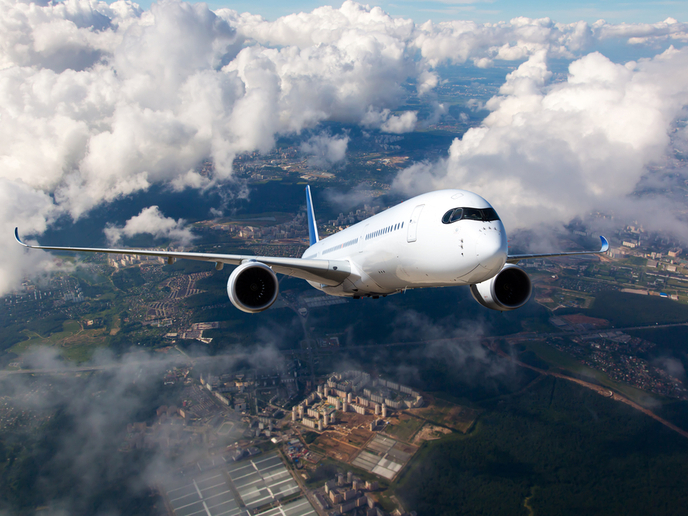Clever composite materials store energy and make aircraft more fuel-efficient
Imagine a high-performance material capable of not only carrying the mechanical load of an airplane, but also storing the electrical energy needed to power its cabin and systems. The result? A new generation of aircraft less reliant on fuel, with twice the flying range of its predecessors. Whilst we are not quite there yet, the EU-funded SORCERER (Structural pOweR CompositEs foR futurE civil aiRcraft) project has already developed revolutionary structural supercapacitors and structural batteries that can be combined to further the electrification of next-generation aircraft. Emile S. Greenhalgh, Royal Academy of Engineering chair in emerging technologies, discusses the new technology, its potential and its path to commercialisation.
Besides early prototypes and R&D by manufacturers, electric aircraft still seem like a distant dream. Would you say otherwise? What are the main remaining obstacles to get there?
Emile Greenhalgh: I think fully electric large passenger aircraft are a long way off – the principal hurdles being the very high energy densities required. Even if those are achieved, the safety issues associated with containing huge amounts of energy in a small volume would remain. I think this is why companies are now moving towards H2 as a route for clean energy. But that doesn’t mean more electrification is not achievable. The cabin and aircraft systems, which conventionally draw energy from the engines, could very well benefit from new electricity-based energy production technologies. There we are targeting structural power. Besides, smaller aircraft and drones are a much more realistic option for the electrification of propulsion. I actually anticipate market growth in these areas.
Your project focuses specifically on energy-storing composite materials. Why are these important and what technological gaps did you aim to close exactly? Also, what made your consortium particularly well equipped to tackle these challenges?
Structural power is a very elegant way of addressing the double challenge of reducing aerostructures’ weight and providing energy storage solutions. We know that traditional electrochemistry is pursuing ever-higher energy densities, but as I mentioned earlier, these are going to present enormous challenges from a safety perspective. Structural power offers an alternative that addresses the electrification of aircraft while not requiring ridiculously high energy densities. To give you an example, we’ve demonstrated that, in an airtaxi like the City Airbus, replacing the conventional batteries and structures with our multifunctional materials for a given energy density will more than double the range of the aircraft. Our consortium consists of world-leading groups in the development of structural supercapacitors (Imperial and IMDEA Materials) and structural batteries (Chalmers and KTH), so we are best placed to move this technology forward. Imperial, Chalmers and KTH have been pioneering this technology for over 10 years.
What would you say makes your project particularly innovative?
We have a completely new approach to using structural materials. Multifunctional materials tend to be considered as having multiple physical functions (electronic and optical for instance), but rarely additional functions that include mechanical function. This is because combining a mechanical function with additional physical functions imposes conflicting demands on the material. For instance, achieving high mechanical stiffness calls for rigid constituents. Yet, to enable transport phenomena (such as ionic flow), they need to be soft. Our approach has been to provide means to tailor the microstructure of the material in order to control the balance between different functions.
What are the project’s main outcomes and achievements so far?
Initially we aimed to reach performance targets for our structural supercapacitors and batteries, as well as to demonstrate them in a final component. From the perspective of structural supercapacitors, we have achieved 1.4 Wh/kg and 1.1 kW/kg energy and power densities, respectively. We are also building an aircraft door demonstrator. IMDEA demonstrated their structural supercapacitors as part of the casing for a systems box. For the structural batteries, we are producing a composite laminate with multifunctional cells. The project ends in January 2021, and we anticipate being able to show the demonstrators by then.
By the time the project ends, how close will we be to actual use in aircraft?
Quite far actually, because this is such a revolutionary technology. It will take a lot of development to be airworthy. Aerospace is traditionally a very conservative sector, but I anticipate that in non-critical applications and perhaps on smaller vehicles (such as drones), structural power could be adopted relatively soon – maybe within the next 5 years?
What are your follow-up plans?
From a personal perspective, I’ve just been awarded the Royal Academy of Engineering chair in emerging technologies, which means I have funding to work on this for the next 10 years. From the perspective of the consortium, we are still talking to Airbus about a future project in this area. We did not receive funding from the EU to take structural power forward, but we hope to be awarded funding in the future in this area.



